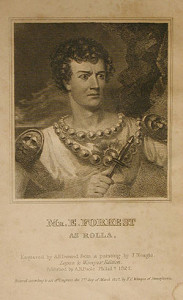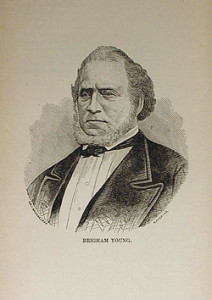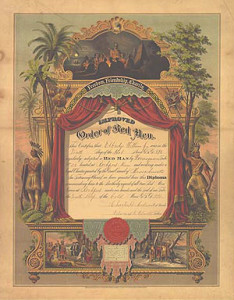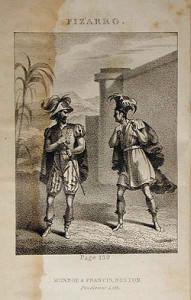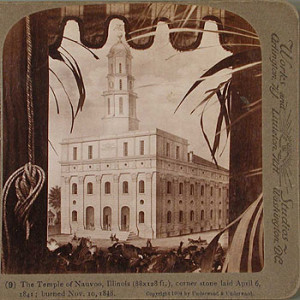The Inca Priest on the Mormon Stage
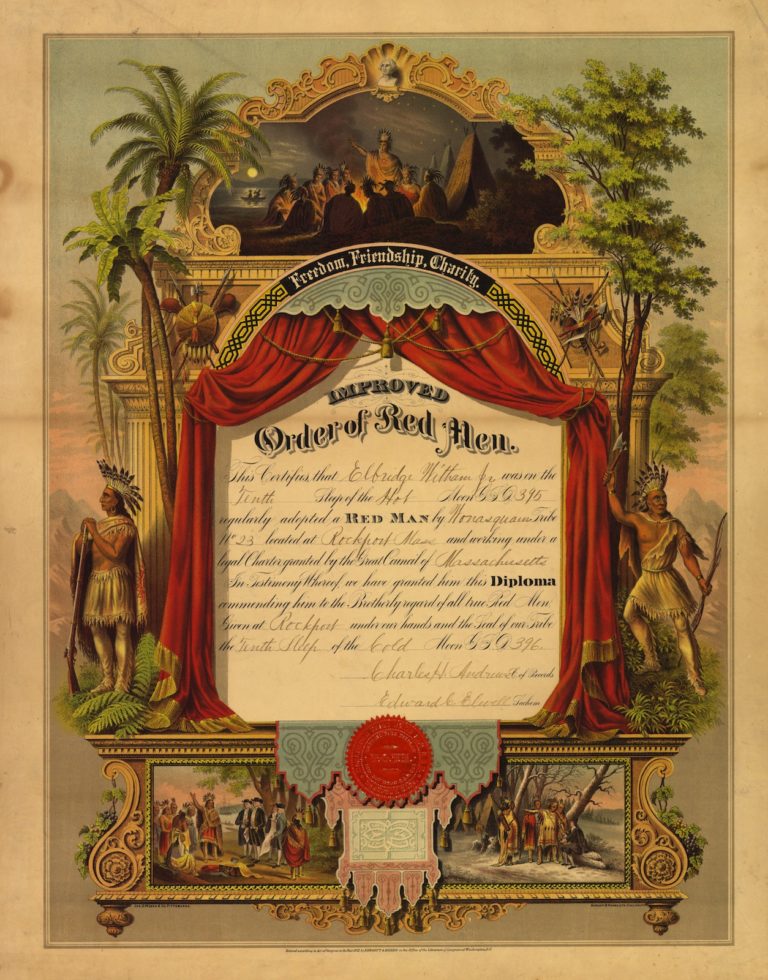
I.
A Native American melodrama and a new American religion
On a warm April evening in 1844, in the social hall of Nauvoo, Illinois, Latter-Day Saint Brigham Young strode onto the stage in costume and makeup. In Nauvoo, the Mormons’ utopian city on the Mississippi, Young was one of the most trusted lieutenants of Joseph Smith Jr., the Mormons’ founder and prophet. No one in the theater could have known that within a few months Smith would lie dead at the hands of an anti-Mormon lynch mob; or that Young would take command of the community and lead it to a new home in the far west, by the Great Salt Lake. This April night, with the first play ever to be staged in a Mormon theater, was a night for escape for the embattled community. Yet there was something curious about the role in which Brigham Young was cast.
Brigham Young took the stage as a high priest, but not a Mormon or other Christian high priest: he played, rather, the pagan high priest of Peru’s prehispanic Inca Empire. He led a solemn procession of priests and virgins to the sacred altar of the sun. Singing a hymn that began, “O Pow’r supreme!” he called fire down from the heavens to set alight his offering at the altar—a trick that the amateur stagehands successfully managed at this maiden performance in Nauvoo. At a moment when Protestant America looked upon Mormons as an alien body in the heart of the republic, one of their highest priests indulged in an extraordinary act of cross-dressing, flaunting the Mormons’ affinities to a barbaric empire and a pagan faith.
The play was Richard Sheridan’s Pizarro (1799), a melodrama about the Spanish conquest of Peru, and a popular stock play in England and America. It was not an unusual selection for Nauvoo’s first play; but Young’s cameo appearance suggested a special self-consciousness in this particular staging. Pizarro, in fact, went on to become something like the Mormons’ national play, a reliable favorite over the decades. When the first theater opened in Utah in 1852, its maiden performance was again Pizarro, and another rising elder in the church played the high priest. Why Pizarro, why the high priest?
I first learned of the Mormons’ love of Pizarro while working as a research assistant for a distinguished historian of the American West. I had a longtime fascination with both the Latter-Day Saints and the Inca Empire. To find this point of contact across centuries and hemispheres gave me something of the confused pleasure one feels on learning that two good friends know each other independently from oneself. What had brought the Incas and Mormons together?
As I pursued this question, I followed a trail that led from the theatrical fads and racial prejudices of Jacksonian America, past fraternal clubs such as the Masons and the Improved Order of Red Men, past the Enlightenment revival of Hispanic scholarship and the anthropology of the nineteenth century, to the synthesis of all of these in the extraordinary cultural creativity of the early Mormon Church. This odd footnote to theatrical history, the striding on stage of one high priest to play the role of another, in fact holds within it a miniature panorama of the fantasies and enthusiasms of the early United States.
II.
Sheridan’s Pizarro opens in 1534, with the Spaniard Francisco Pizarro waging a war of conquest against the Inca Empire of Peru. Alonzo, a young comrade of Pizarro, has become disgusted with Spanish barbarity, has crossed over to become the leader of the Inca army, and has married the Inca emperor’s daughter Cora. Both as general and as lover, Alonzo has displaced the dashing Inca hero Rolla, who nevertheless remains his loyal friend. In a climactic battle, Rolla, Pizarro, and the Inca emperor are all killed. The Spaniard Alonzo and his Inca wife survive, along with their infant son, whom the Inca Rolla has died protecting. They will mourn the dead and found a new society on the ruins of the Inca Empire.
In real life, there was no Rolla, Alonzo, or Cora; no side-changing general; no climactic battle. Pizarro took the Inca emperor captive through an act of treachery, obtained from him an immense ransom, then had him killed. Controlling an empire that included modern Ecuador, Peru, Bolivia, and parts of Chile and Argentina, the conquistadores fell to fighting among themselves. Several years after murdering the Inca emperor, Pizarro himself fell victim to Spanish assassins.
What drew nineteenth-century audiences to a play that chronicled a remote chapter of history, and did so completely inaccurately? Whatever it was about the Incas that attracted the English playwright (and the German author from whom he adapted the play), American audiences saw Pizarro primarily as an allegory about Native Americans and European settlers, and thus an interpretation of their own national situation. Pizarro fit squarely within the popular Anglo-American literary tradition of the vanishing Indian.
During the antebellum years when Pizarro was most popular, the campaign to remove southeastern native peoples to the far side of the Mississippi elevated ethnic cleansing to national policy. Yet books that celebrated Native Americans, such as Longfellow’s “Song of Hiawatha,” were bestsellers. The impulses to deport and to celebrate Indians were closely linked: Edwin Forrest, the nation’s foremost actor, advocated Indian removal while at the same time commissioning plays in which he starred as a noble Indian who died tragically. The result of the hero’s death, in such plays, is that Indians melt away and are replaced by whites who mourn their passing, even while they benefit from it. One of Forrest’s favorite roles was Pizarro’s Rolla.
Historian Philip Deloria has argued that a fundamental theme of American culture is a simultaneous effort to displace Native Americans and to inherit, borrow, or perform Native American identity—a practice that he calls “playing Indian.” Pizarro’s elegiac mood—glamorizing the Inca Empire as it went down to defeat—spoke to this ambivalent engagement with Native Americans.
If this ambivalence was a prominent theme in antebellum America, it was even more central to the brand-new Mormon religion. The Book of Mormon, said to have been revealed by an angel in 1827, is in fact a history of ancient Native Americans. Its protagonists are Israelites who came to America by sea in 600 B.C. before splitting into two groups, the good Nephites and the evil Lamanites. Eventually the Lamanites—the ancestors of modern Indians—exterminated their Nephite cousins. The Nephites’ last act was to leave the Book of Mormon to be discovered by Joseph Smith, their latter-day heir.
Just as their contemporaries wept for dying Indian heroes while voting to deport living Indians to the Great Plains, Mormons extolled the lost Nephites but had more troubled relations with the modern-day “Lamanites,” who they believed had received dark skin as a curse for their wickedness. In this context Pizarro—in which ancient Indians die tragically and bequeath their empire to a virtuous European—seems a natural choice for the Mormons’ first theatrical production. Rolla’s noble resignation distantly echoed the Nephite Moroni’s long before (dated at 480 A.D.), which closed the Book of Mormon.
III.
One point, however, remains mysterious. Brigham Young—a dominating figure and the main promoter of the 1844 performance—did not play either the tragic Rolla or the victorious Alonzo. He played the Inca high priest. This character had few lines and no role in the plot, yet was considered one of the most important in the play. The leader of a theatrical troupe typically cast himself either as Rolla or as the high priest. What was it about this incidental character that attracted Brigham Young and his contemporaries?
One possible clue, unlikely as it seems: in 1842, two years before Pizarro reached Nauvoo, the leaders of the Mormon church became Masons. The ritual world of secret fraternal clubs may have had more to do with Pizarro’s success—and Brigham Young’s performance—than meets the eye.
Reading Pizarro’s stiff and bombastic lines today, I had some trouble understanding its popularity, and some contemporaries had the same reaction. Even the editor of one 1846 edition suggested that the play’s appeal lay less in its writing than in its “scenery, music, and processions.” This aspect of pure, exotic spectacle was centered in the high priest’s procession, which formed an interlude in the play. It also connected the play to Masonic performance.
Men’s fraternal clubs, such as the Masons, Odd Fellows, and Knights of Pythias, were theaters of ritual, allegorical performance, as formal and complex as anything on the public stage. But the mode of performance was distinct from stage acting: it was slow, solemn, and gestural, much like the high priest’s interlude in Pizarro. Furthermore, fraternal rituals had a religiosity resembling that of the Incas in Pizarro. More deist than Christian, they often involved pagan and exotic figures. The prayer in Pizarro to the “pow’r Supreme” could have come from a Masonic initiation. Even the title “high priest” was Masonic.
There were even clubs that specialized in “Indian” performances. Their imagined Indians were much like the characters in Masonic dramas: ancient, departed, and deist. (Some groups sought more authenticity: Lewis Henry Morgan, the father of American anthropology, actually began studying Iroquois ethnography as material for his own club’s rituals.) One group, the Improved Order of Red Men, adopted a ritual that was strikingly similar to the high priest’s in Pizarro: during a new member’s initiation, a “prophet” stands before an extinguished council fire and calls, “Oh let thy sacred fire descend,” and the fire is mystically lit from above. The Red Men, in fact, may have borrowed their ritual from the often-staged Pizarro.
Joseph Smith’s adoption of Masonry was no mere whim. He immersed himself in the study of Masonic ritual in order to reform what he considered a sacred but corrupted tradition. The new body of ritual he created for the Mormons included initiation rites for a new priesthood with mysterious signs and secret, allegorical dramas—the latter with roles such as Adam and Eve, Solomon, and Satan. Brigham Young was an important participant in this process of innovation. Elements of ritual theater, indeed, pervaded Mormon religion. As the Inca high priest in Pizarro, Young gave a ritual performance neither more nor less exotic and theatrical than in his day job as a Mormon high priest.
IV.
Jacksonian Indian melodrama and Masonic ritual are two contexts for understanding Brigham Young’s performance in Pizarro. But what of the Incas themselves? An Enlightenment revival of Hispanic scholarship had made English-speaking readers familiar with the Inca Empire as a profoundly alien society, yet one that was in many ways admirable. The Inca, according to much of this literature, were authoritarian in their politics but that authoritarianism produced admirable order and happiness. The success of Sheridan’s Pizarro in 1799 created a new wave of interest in the Incas among English speakers. The next year saw the publication of a children’s dialogue about the Incas, with lines such as: “Excellent people! Who can avoid respecting them?” But the most influential Enlightenment account of the Incas was contained in William Robertson’s History of America (1777), reprinted many times over the following decades in England and America.
If he read this account, Brigham Young might have recognized similarities to his own Mormon people. Robertson’s History portrayed the Inca Empire as a uniquely authoritarian, communitarian, and yet well-ordered society. “In Peru,” he wrote, “the whole system of policy was founded on religion. The Inca appeared not only as a legislator, but as the messenger of Heaven.” The divine commands channeled by the Inca emperor extended to practical as well as spiritual matters, and the management of land was “regulated by public authority in proportion to the exigencies of the community.”
Robertson might have been describing the Mormon Church. The Bostonian Josiah Quincy, visiting Nauvoo in 1844, had this to say of Joseph Smith’s theocracy: “No association with the sacred phrases of Scripture could keep the inspirations of this man from getting down upon the hard pan of practical affairs. ‘Verily I say unto you, let my servant, Sidney Gilbert, plant himself in this place and establish a store.’ So had run one of [Smith’s] revelations.”
Aspects of Mormon religion were mirrored in accounts of the Incas. Writers had long celebrated the Incas’ dignified and rational cult of the sun, enacted by the high priest in Sheridan’s play. An American edition of the play shows Edwin Forrest as Rolla wearing an image of the sun on his chest. The enigmatically smiling face of the sun was likewise visible on the capstone of Nauvoo’s Mormon temple, reflecting the same Enlightenment (and Masonic) traditions of esotericism and natural religion that made the Incas so attractive. In addition to worshiping the sun, the Incas believed that their emperors were gods as well as men. And as scholar Nola Diane Smith has pointed out, it was just a few weeks before the staging of Pizarro that Joseph Smith, in Nauvoo, preached his famous doctrine that our God was once a man, and that we may one day be gods of our own worlds.
While this notion struck most American Christians as heretical, the most infamous Mormon doctrine promoted polygamy. Outrage against polygamy was soon to lead to Joseph Smith’s murder, and would cause half a century of conflict between the Mormons and the society around them. Their enemies referred to it as a “relic of barbarism.” This was one more practice the Mormons shared with the barbaric Inca Empire, where the emperor (like Joseph Smith and Brigham Young) married dozens of wives.
Enlightenment histories of the Incas portrayed a society that was fundamentally alien to Anglo-American norms but was nevertheless happy and well ruled. When Brigham Young took the stage in the role of the Inca priest, he made a statement that he could not have made by playing one of the other Native American dramatic heroes. His casting created an inevitable association between the hated Mormons and the admired Incas. It invoked a literary tradition that praised precisely those deviations from Anglo-American norms for which the Mormons themselves were most reviled.
It is far from certain that any such calculation was in Brigham Young’s mind when he mounted the stage as the Inca high priest. But there is evidence that Mormons, like other North Americans, were aware of the Incas’ claims to sympathy. In 1850, the Mormon newspaper printed a letter ostensibly from a descendent of the last Inca emperor, calling upon the president of the United States to invade Peru and reinstate the Incas “in their ancient splendor.”
The selection of Pizarro to open up the Mormons’ very first theater, in Nauvoo in 1842, was not an anomaly; as we have seen, the play became a Mormon tradition. Years later, the man who had directed the play boasted that he had been the first to cast Brigham Young as the high priest, adding, “[H]e’s been playing the character with great success ever since!”
Further Reading:
A wonderful introduction to the history of Mormon theater is Howard R. Lamar, The Theater in Mormon Life and Culture, Leonard J. Arrington Mormon History Lecture Series 4 (Logan, Ut., 1999); this essay began in conversations with Professor Lamar and is dedicated to him. I am also very much indebted to Nola Diane Smith’s “Reading across the Lines: Mormon Theatrical Formations in Nineteenth Century Nauvoo, Illinois” (Ph.D. diss., Brigham Young University, 2001), although our interpretations are different.
On the play Pizarro, see Myron Matlaw, “‘This is Tragedy!!!’ The History of Pizarro,” Quarterly Journal of Speech 43 (1957): 288-94. On the tragic Indian theme in American theater, see B. Donald Grose, “Edwin Forrest, Metamora, and the Indian Removal Act of 1830,” Transcendental Journal (May 1985). On “playing Indian,” see Philip J. Deloria, Playing Indian (New Haven, 1998). On Mormon religious ritual, see David John Buerger, The Mysteries of Godliness: A History of Mormon Temple Worship (San Francisco, 1994). On fraternal ritualism, see Mark C. Carnes, Secret Ritual and Manhood in Victorian America (New Haven, 1989). On Enlightenment images of the Incas, see Fernanda Macchi, “Imágenes delos Incas en el Siglo XVIII” (Ph.D. diss., Yale University, 2003).
Primary source quotations not fully identified in the text are drawn from: Richard Brinsley Sheridan, Pizarro: A Play in Five Acts, ed. Epes Sargent (New York, 1846), v.; Joachim Heinrich Campe, Pizarro; or, The conquest of Peru, trans. Elizabeth Helme (Boston, n.d.), 92; William Robertson, The History of America, 14th ed., 3 vols. (London, 1821), 3: 49, 57; William Mulder and A. Russell Mortensen, eds., Among the Mormons: Historic Accounts by Contemporary Observers (New York, 1958), 135, 137; Salt Lake City Deseret News, June 22, 1850; John S. Lindsay, The Mormons and the Theatre; or The History of Theatricals in Utah (Salt Lake City, 1905), 7.
This article originally appeared in issue 5.4 (July, 2005).
Jeremy Ravi Mumford received his Ph.D. in history this year from Yale University, and is Mellon Postdoctoral Fellow in the History of the Atlantic World at Brandeis University. His current research is on Native Americans, in both Americas, who filed lawsuits in colonial courts.
